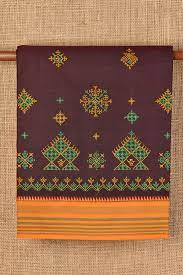Dharwad Kasuti is the most famous style of embroidery in Karnataka. The uniqueness of Dharwad Kasuti is that it just needs a needle, thread and creative mind coupled with patience and time. The artisans do not use traced drawings for embroidery. It is done directly on the cloth by counting the warp and weft threads.
This traditional form of embroidery unique to Karnataka, reflects the art, culture and nature of the State. The craft is conceived, pursued and dominated by women and has become a medium for expressing their creativity. Pursued as a hobby in the in the olden days, it is embedded in the culture of the region and has also become a source of livelihood for many.
The origin of this craft can be traced back to the period of Chalukya dynasty, between the 6th and 12th centuries. This handicraft, which originated in the old provinces of North Karnataka, later travelled to the southern parts of the State during the Vijayanagar and Mysuru dynasties.
Fascinated by the beauty of Dharwad Kasuti, many fashion designers have incorporated it in their work. Though normally seen on cotton saris, the designers from National Institute of Fashion Technology (NIFT) have used it to add glamour to Mysore Silk sarees. These days Dharwad Kasuti is done Kanjivaram and cotton sarees also.
(This blogpost is a part of Blog chatter's #BLOGCHATTER A2Z2023)



Creating symmetrical geometric designs that look identical on both sides of the cloth? That sounds like a tedious and detailed job. No wonder the embroidery turns out looking so beautiful
ReplyDeleteYes
DeleteVery detailed post. I wasn't aware of this style of embroidery. Looks very tedious but the results must be awesome i am sure
ReplyDeleteExactly
Delete